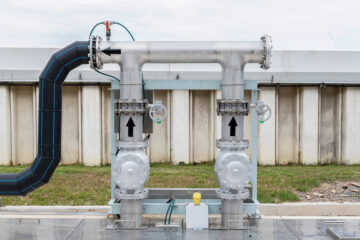
Over the past 30 years, we witnessed a surge of 50% in global greenhouse emissions, mainly due to increased fossil combustion. Going green as a business is a way to contribute to the wellbeing of our planet and future generations. And it’s definitely a savvy business strategy, as consumers are becoming increasingly aware of the importance of choosing eco-conscious brands.
So, adopting a sustainable business model is a win-win situation. Surveys show that Gen Z is more interested in making sustainable purchasing decisions than following popular brand names.
Here are some tips for making your business more eco-friendly.
1. Monitor and Reduce Energy Workplace Energy Consumption
Analyze your utility bills and start with some simple energy-conserving practices, such as turning off the lights, equipment, or appliances when you’re not using them. Use natural light whenever possible and implement smart motion sensors in corridors and restrooms.
Another good idea is having an energy audit since it will show how energy efficient your business is and identify opportunities for cost savings. Based on the results of this audit, you’ll be able to make an energy-saving strategy and update your equipment with more efficient models to comply with sustainability standards.
2. Encourage Remote Work
Not every business can entirely switch to working from home, but a partially remote or hybrid workforce is an option in many cases.
First of all, if your employees work from home, your electricity bill will be significantly lower. In some cases, it’s even possible to downsize from a huge to a smaller office space, thus cutting costs and energy usage even more.
Secondly, when employees work from home, they don’t have to use their cars to get to the office, and this means reducing harmful emissions and air pollutants. There are other eco benefits of this approach since people won’t have to buy coffee to go or order packed lunches in disposable containers.
3. Promote Sustainable Commuting
Not all businesses can adopt a remote working model, and even in that case, it’s possible to reduce harmful greenhouse emissions by incentivizing sustainable commuting.
For example, you can offer discounted bike-share subscriptions or interest-free loan programs for those who want to buy a bike. Some companies buy second-hand refurbished bikes from charities and sell them to your employees at a fraction of the price.
When it comes to green transportation, there’s also an option to use street-legal golf carts. They’re much cheaper than regular cars and are much more fuel-efficient. Electric carts produce no harmful emissions.
4. Go Paperless
By digitizing your work processes and going paperless, you’ll produce significantly less waste and save trees. On top of that, you’ll also save a lot of time and space. Not to mention that digital versions of your business documents are much safer and more easily accessed in the cloud.
With all kinds of different digital services available, there are numerous paperless procedures you can adopt. For example, accounting, time tracking, expense tracking, and signatures can be completely digitized.
However, if you can’t transition to the paperless system, you can reduce your environmental impact by switching to recycled or post-consumer-waste paper and packaging.
5. Get Rid of Disposable Pens and Office Supplies
Just like plastic kitchenware, disposable pens are bad for the environment. According to statistics, 9 billion used pens end up in landfills all around the world annually.
To minimize your ecological footprint, opt for wooden pencils and reusable pens with refills.
Similarly, single-use batteries might be more affordable initially, but they pose a great ecological threat, so it’s much more environmentally friendly and cost-effective to invest in rechargeable batteries.
The odds are your office pantry is packed with non-sustainable tableware made of plastic and other non-green materials. Reusable cups, glasses, and plates can go a long way toward making your business greener.
Finally, bottled water is the archnemesis of our environment. Invest in a water filtration system in the workplace and ask your employees to use reusable bottles.
6. Recycle and Buy Refurbished Electronics
More than 50 million metric tons of e-waste are produced annually worldwide. What’s even worse is that electronic waste contains several toxic chemicals, including lead, mercury, and cadmium.
Instead of contributing to environmental pollution, it’s a much better idea to participate in electronic recycling programs and conserve resources. These initiatives help you dispose of your unwanted computers, cell phones, and other electronic equipment in an ecologically safe way. Plus, this waste is then used to produce raw materials that can be reused in the production of new products.
Another great way to save while helping a good case is to buy refurbished laptops, keyboards, headphones, and other electronic devices instead of brand-new ones. These slightly used gadgets have been tested and, if necessary, repaired. They usually cost up to 50% less than unused electronics and come with a limited warranty.
In Conclusion
By implementing these simple steps, your business can benefit from long-term advantages while building an eco-friendly reputation. You can be sure that a smaller carbon print will appeal to your customers and attract those willing to pay more for sustainable products and services.
- SEO Powered Content & PR Distribution. Get Amplified Today.
- Platoblockchain. Web3 Metaverse Intelligence. Knowledge Amplified. Access Here.
- Source: https://usgreentechnology.com/6-ways-to-make-your-business-greener-this-year/
- a
- Able
- accessed
- According
- Accounting
- adopt
- Adopting
- advantages
- affordable
- AIR
- All
- and
- Annually
- appeal
- appliances
- approach
- around
- audit
- available
- Bad
- based
- batteries
- becoming
- benefit
- benefits
- Better
- Bill
- Billion
- Bills
- brand
- brands
- Building
- business
- business model
- businesses
- buy
- carbon
- cars
- case
- cases
- cell phones
- Charities
- cheaper
- chemicals
- choosing
- Cloud
- Coffee
- come
- commuting
- Companies
- completely
- computers
- Consumers
- Containers
- contains
- contribute
- contributing
- Cost
- cost savings
- cost-effective
- Costs
- Customers
- cutting
- decisions
- definitely
- Devices
- different
- digital
- digital services
- digitized
- digitizing
- dispose
- documents
- Dont
- easily
- Ecological
- efficient
- Electric
- electricity
- Electronic
- Electronics
- Emissions
- employees
- encourage
- energy
- entirely
- Environment
- environmental
- environmentally
- environmentally friendly
- equipment
- Ether (ETH)
- Even
- Every
- example
- expense
- following
- Footprint
- fraction
- friendly
- from
- future
- Gadgets
- Gen
- Gen Z
- generations
- get
- gif
- glasses
- Global
- Go
- going
- golf
- good
- great
- Green
- harmful
- having
- headphones
- help
- helping
- Home
- How
- HTTPS
- huge
- Hybrid
- idea
- identify
- Impact
- implement
- implementing
- importance
- in
- Including
- increased
- increasingly
- initially
- initiatives
- instead
- interested
- Invest
- IT
- laptops
- lead
- light
- Limited
- loan
- Long
- long-term
- Lot
- made
- make
- Making
- many
- materials
- means
- Mercury
- metric
- might
- million
- minimize
- model
- models
- Monitor
- more
- more efficient
- motion
- names
- Natural
- necessary
- New
- new products
- numerous
- Odds
- offer
- Office
- opportunities
- Option
- order
- Other
- packaging
- packed
- Paper
- participate
- past
- Pay
- pencils
- People
- phones
- planet
- plastic
- plato
- Plato Data Intelligence
- PlatoData
- plus
- Pollution
- Popular
- possible
- practices
- price
- procedures
- processes
- produce
- Produced
- Production
- Products
- Products and Services
- Programs
- promote
- purchasing
- Raw
- recycling
- reduce
- reducing
- regular
- remote
- remote working
- reputation
- Resources
- Results
- reusable
- Rid
- safe
- safer
- Save
- Savings
- savvy
- sell
- sensors
- Services
- several
- show
- Signatures
- significantly
- Simple
- since
- situation
- smaller
- smart
- So
- some
- Space
- standards
- start
- statistics
- Steps
- Strategy
- subscriptions
- such
- surge
- Sustainability
- sustainable
- Switch
- system
- The
- the world
- their
- this year
- threat
- time
- tips
- to
- top
- toward
- Tracking
- transition
- transportation
- Trees
- Turning
- UN
- unused
- unwanted
- Update
- Usage
- use
- usually
- utility
- Waste
- Water
- ways
- wellbeing
- while
- WHO
- will
- willing
- witnessed
- wooden
- Work
- work from home
- Workforce
- working
- working from home
- Workplace
- world
- worldwide
- year
- years
- Your
- zephyrnet









